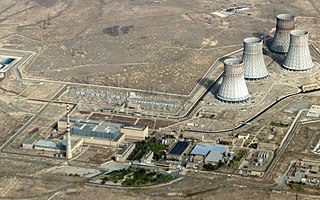Loading AI tools
Minimum level of demand on an electrical grid over a span of time From Wikipedia, the free encyclopedia
The base load[2] (also baseload) is the minimum level of demand on an electrical grid over a span of time, for example, one week. This demand can be met by unvarying power plants[3] or dispatchable generation,[4] depending on which approach has the best mix of cost, availability and reliability in any particular market. The remainder of demand, varying throughout a day, is met by intermittent sources together with dispatchable generation (such as load following power plants, peaking power plants, which can be turned up or down quickly) or energy storage.

Power plants that do not change their power output quickly, such as some large coal or nuclear plants, are generally called baseload power plants.[3][5][6] In the 20th century most or all of base load demand was met with baseload power plants,[7] whereas new capacity based around renewables often employs flexible generation.[8]
Grid operators take long and short term bids to provide electricity over various time periods and balance supply and demand continuously.[9] The detailed adjustments are known as the unit commitment problem in electrical power production.[citation needed]
While historically large power grids used unvarying power plants to meet the base load, there is no specific technical requirement for this to be so. The base load can equally well be met by the appropriate quantity of intermittent power sources and dispatchable generation.[4][10]
Unvarying power plants can be coal, nuclear, combined cycle plants, which may take several days to start up and shut down,[11] hydroelectric, geothermal,[12] biogas, and biomass.
The desirable attribute of dispatchability applies to some gas plants and hydroelectricity. Grid operators also use curtailment to shut plants out of the grid when their energy is not needed.[13][14]

Grid operators solicit bids to find the cheapest sources of electricity over short and long term buying periods.[15]
Nuclear and coal plants have very high fixed costs, high plant load factor[16] but very low marginal costs.[citation needed] On the other hand, peak load generators, such as natural gas, have low fixed costs, low plant load factor and high marginal costs.[17]
Some coal and nuclear power plants do not change production to match power consumption demands since it is sometimes more economical to operate them at constant production levels, and not all power plants are designed for it. The IEA has suggested that coal power plants should not run as baseload, because that emits a lot of carbon dioxide, which causes climate change.[18] Some nuclear power stations, such as those in France, are physically capable of being used as load following power plants and do alter their output, to some degree, to help meet varying demands.[19][moved resource?][20][moved resource?]
Some combined-cycle plants usually fuelled by gas, can provide baseload power,[21][need quotation to verify][obsolete source]as well as being able to be cost-effectively cycled up and down to match more rapid fluctuations in consumption.
According to National Grid plc chief executive officer Steve Holliday in 2015, and others, baseload is "outdated".[8][6] By 2019, Steve Holliday had left his position as CEO of National Grid plc and went on the record to say that, "It’s hard to conceive that nuclear does not have an important role to play"[22]
Seamless Wikipedia browsing. On steroids.
Every time you click a link to Wikipedia, Wiktionary or Wikiquote in your browser's search results, it will show the modern Wikiwand interface.
Wikiwand extension is a five stars, simple, with minimum permission required to keep your browsing private, safe and transparent.